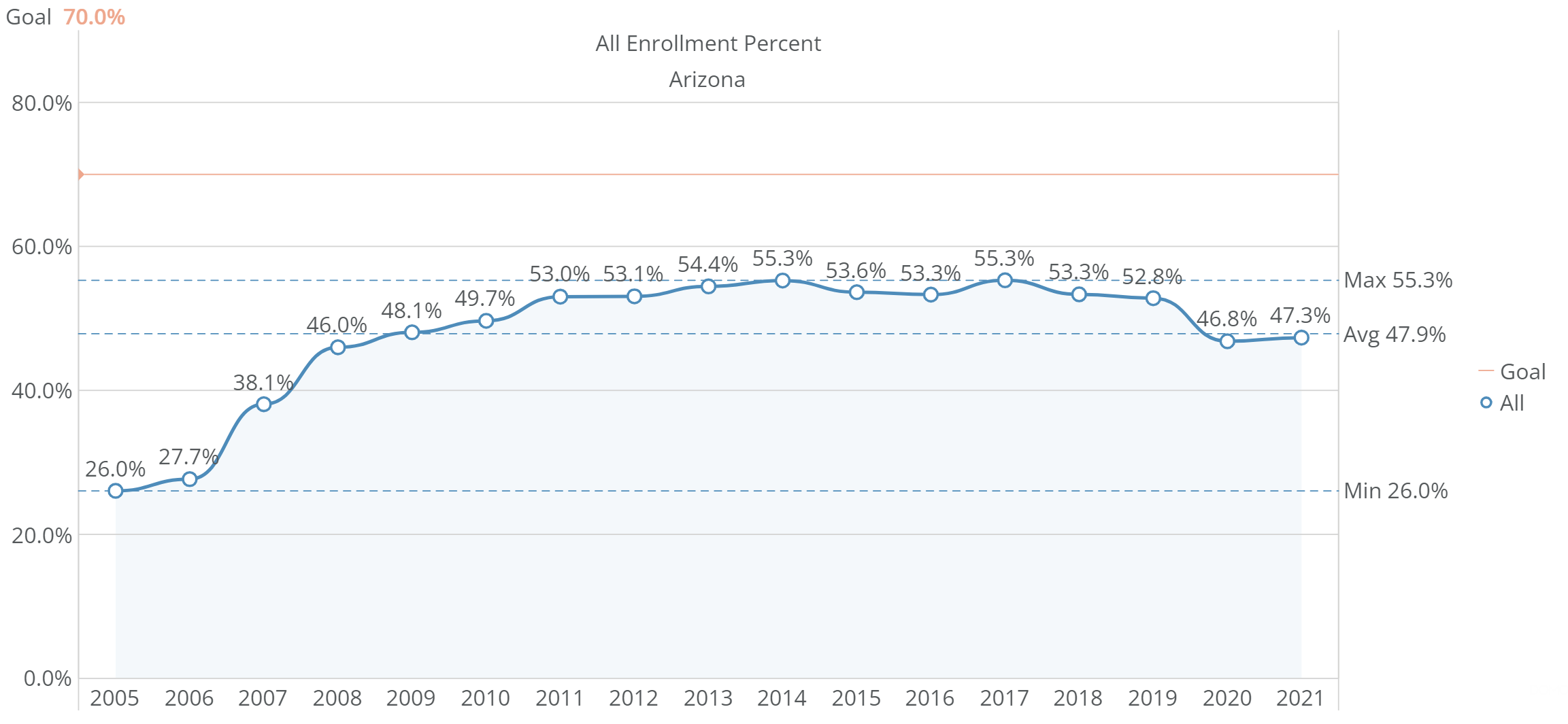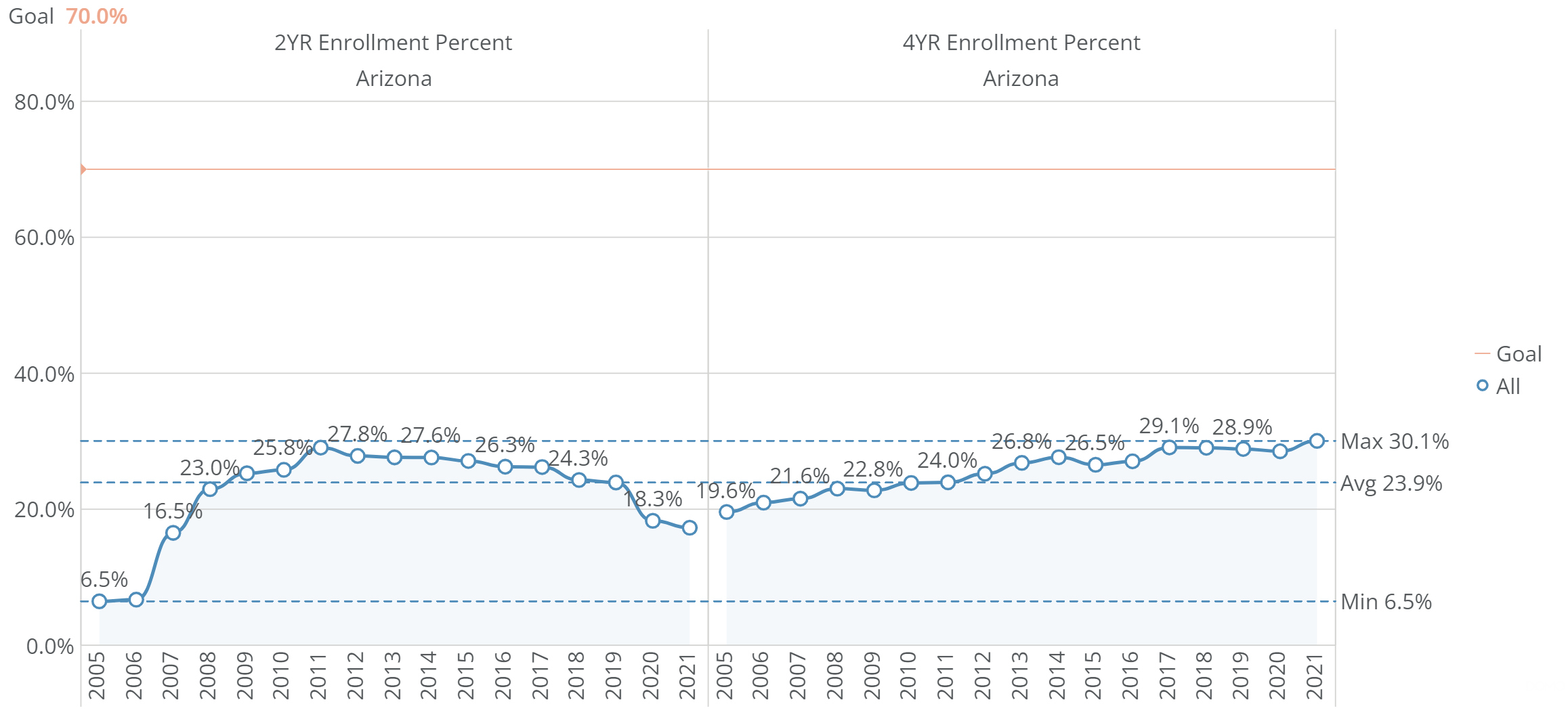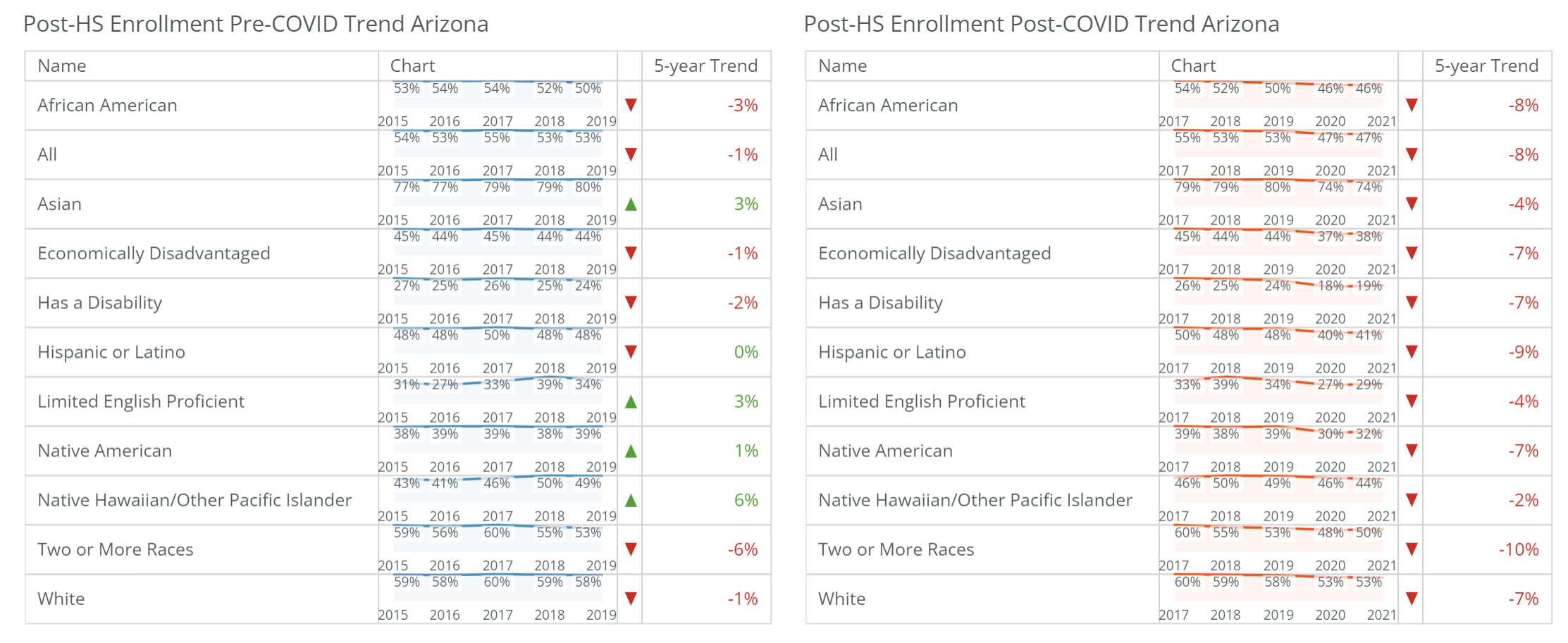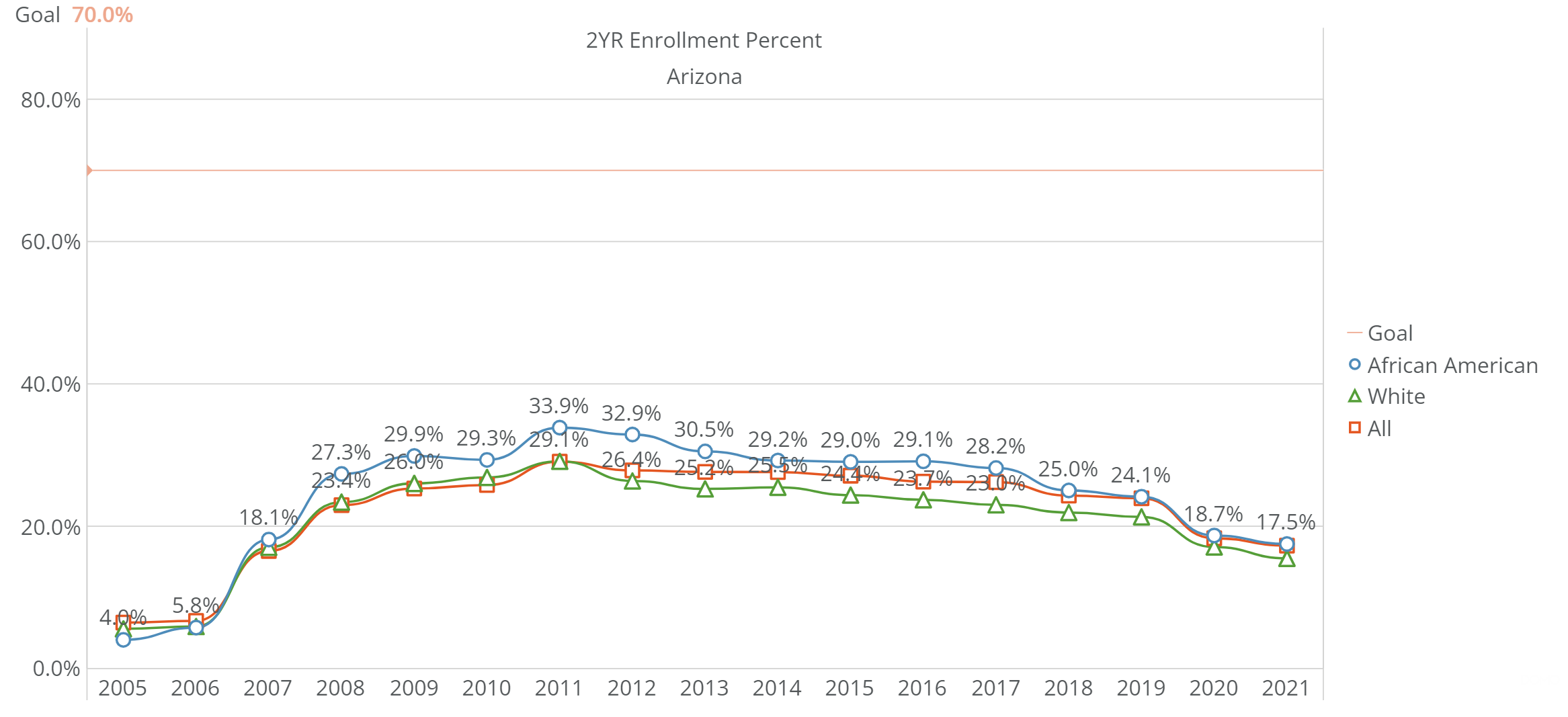Low Post-Secondary Enrollment Numbers Demonstrate Ongoing COVID-19 Impact on Educational Outcomes in Arizona; Resilience in University Enrollment

Center for the Future of Arizona and Education Forward Arizona recently released updates to the Arizona Education Progress Meter, the state’s widely accepted framework for measuring P-20 education.
According to the Arizona Board of Regents’ most recent data, the state’s Post-High School Enrollment rate for the graduating class of 2021 is 47%–much lower than in recent years, due in part to ongoing impacts from the COVID-19 pandemic. While enrollment in four-year institutions, including universities, remains at a steady increase, Arizona high school graduates are enrolling in two-year institutions at rates much lower than their peak in 2011.
Post-High School Enrollment is measured by students who graduated from an Arizona public or charter high school and attended a college, technical school, or university the following academic year. This measure is a good indicator of how prepared and motivated Arizona students are to pursue higher education upon high school graduation. The new numbers from 2021 indicate Arizona has a long way to go to reach the established 70% goal and needs to prioritize action on closing this concerning gap.
Ten years prior to the most recent data, educators and leaders were celebrating ongoing improvements in the share of Arizona high school graduates attending community colleges, universities, and trade schools within one year of completing high school. Spurred by the Great Recession, college enrollment rates more than doubled to 53% from as low as 26% in 2005, the year the most recent data began to be collected. Much of this growth occurred in two-year institution enrollment, which was only 7% in 2005 but had quadrupled to 29% by 2011.
These gains were short-lived. The new data reveal enrollment in two-year institutions is down to only 17%. Enrollment in four-year institutions steadily increased and is now 30%, up from only 20% in 2005 and 24% in 2011. The latest data show that overall, Post-High School Enrollment is only 47%, far from the statewide goal of 70%.
The Arizona Board of Regents also tracks the six-year post-secondary completion rate for Arizona high school graduates. In the most recent release, data indicate that only 28% of Arizona graduates from the class of 2016 completed a post-secondary certificate or degree within six years. Though still low, it is higher than the 23% completion rate for the class of 2005.
Additionally, data updates on Arizona’s Post-Secondary Attainment (adults 25-64 that completed professional certification, associate’s degree, or higher at any point), released earlier this year, show the state is only at 48%, compared to the goal of 60% by 2030.

Figure 1: Recent declines in Arizona's Post-High School Enrollment rate reflect ongoing impacts from COVID-19 and lower trends in enrollment at two-year institutions.

Figure 2: Though enrollment in four-year institutions including Arizona's universities remains on the upward trajectory, two-year enrollment has suffered ten straight years of decline.
Like many of the issues among Arizonans’ Shared Public Values, outcomes in education vary significantly and are often correlated to various demographic factors, including race and ethnicity, disability status, socioeconomic status, and others. Among these demographics, the rates at which students pursue education and training after high school have seen significant improvement across the board since 2005. However, all groups saw pandemic-related declines in post-secondary enrollment, beginning with the graduating class of 2020. Post-secondary enrollment slightly improved for most subgroups in 2021 but remains a challenge.
Even before the pandemic, five-year trends of post-secondary enrollment were flat or declining for Arizona high school graduates. As of 2021, trends have declined further – by 8% for all Arizona high school graduates, 10% for students reporting two-or-more races, 9% for Hispanic or Latino, 8% for African American, 7% for Economically Disadvantaged, 7% for White, 7% for Native American, and 7% for Students with Disabilities. (Figure 3)
Overall, these trends were most evident in enrollment numbers at two-year institutions, especially among groups that attend two-year institutions at a higher rate. Arizona graduates who are African American, for example, attend community colleges and trade schools at much higher rates than their counterparts and therefore see a larger impact in attendance reductions. (Figure 4)

Figure 3: Declines in Post-High School Enrollment started even before COVID-19 for most demographic subgroups.

Figure 4: Until recently, Arizona high school graduates who are African American were much more likely to attend a two-year institution than their White and Asian counterparts. Declines in two-year institution enrollment are acute in this subgroup which has seen reductions of about half since 2011.
The latest data released also show only 28% of Arizona high school graduates from the class of 2016 completed a post-secondary certificate or degree within six years. That means over 70% of the 70,000 graduates from 2016 have not completed a credential within six years, which causes significant concern about the preparedness of students for education, training, and careers after high school and the systems that support them toward a successful outcome.

Figure 5: 28% of Arizona high school graduates from the class of 2016 completed a post-secondary certificate or degree in six years.
Why is Post-Secondary Enrollment and Attainment Important?
Arizonans agree on their importance to our long-term prosperity. In CFA’s latest Gallup Arizona survey that identified Arizonans’ seven Shared Public Values, including Education, 84% of residents believe a highly educated and skilled population is good for our state’s economy. Yet only 26% believe our K-12 education system is high quality.
Roughly two thirds of all jobs in the economy require post-secondary education and training beyond high school. But today, there aren’t nearly enough adults in Arizona with the training or education beyond high school needed to support the economy we want.
There is also a vast amount of research and evidence that reinforces why prioritizing higher education and post-secondary attainment is crucial at the individual, community, and statewide levels. Recent research from Helios Education Foundation and Education Forward Arizona shows Arizonans who pursue education after high school experience expanded career opportunities, increased earning potential, and improved overall well-being. From a broader economic standpoint, a highly skilled and educated workforce drives economic growth, fosters innovation, reduces unemployment and poverty, generates tax revenue, and promotes social and economic mobility.
Moving Arizona Forward
If we increase post-secondary enrollment and attainment in Arizona and reach the Arizona Education Progress Meter goals, the state will make significant progress in achieving the economic and quality of life aspirations Arizonans want for the state.
A broad and representative majority of Arizonans agree on a number of actions to improve education and to ensure every Arizonan is prepared for success in life and work. These supported actions include increasing the number of Arizona high school graduates that enroll in universities, community colleges, or technical/trade schools and reducing the financial barriers to higher education.
This is why CFA is focused on informing leaders and communities, convening partnerships, and implementing statewide programs to advance Arizonans’ priorities, including:
- Bringing together industry and education to provide seamless college & career pathways for students with quality career exploration, early college programs of study, and work-based learning
- Empowering and supporting educators with reimagining classroom learning
- Strengthening school and district leaders and the leaders guiding workforce development
The time for accelerating action is now. By prioritizing collaborative solution-building and making strategic investments, we can all contribute towards ensuring more Arizonans pursue education and training after high school. This is essential to achieve The Arizona We Want.
Dig Deeper – Analyze Data to Support Investment and Action
Data are available for all Arizona public and charter high schools, districts with high schools, cities, counties, and the state as a whole.
- Learn more and find all data and tools, including Post-High School Enrollment, at the Arizona Education Progress Meter
- Post-Secondary Completion data is located at the bottom of Post-Secondary Attainment
- Compare data using this dashboard specific to post-secondary enrollment and completion
Reach out to our team if you have questions or need assistance with the data tools.
About Our Data Sources
As with all the Arizona Progress Meters, data are publicly available from a trusted and regularly updated source. Data used in the education metrics come from the Arizona Department of Education, the U.S. Census Bureau, the Arizona Board of Regents, and the U.S. Student Clearinghouse.
The Arizona Board of Regents sourced the post-secondary enrollment and completion data from the Arizona Department of Education and the National Student Clearinghouse. Data include all students who graduated from a public or charter high school and attend any college, trade school, or university in the United States. A very small number of students who opt out of sharing data or graduated from a private school do not show up in the numbers.
For more information, see our full methodology.
About Arizona Progress Meters
CFA developed the Arizona Progress Meters as a tool for policymakers, business leaders, civic leaders, educators, and others across the state to understand how Arizona is doing in areas critical to achieving The Arizona We Want. Eight Arizona Progress Meters provide valuable and regularly updated data on 80+ metrics in education, jobs, healthcare, environment, civic engagement, infrastructure, and more to support policymakers and other leaders’ data-driven dialogue, decision-making, and action. Learn more and leverage all the Arizona Progress Meters today >>
